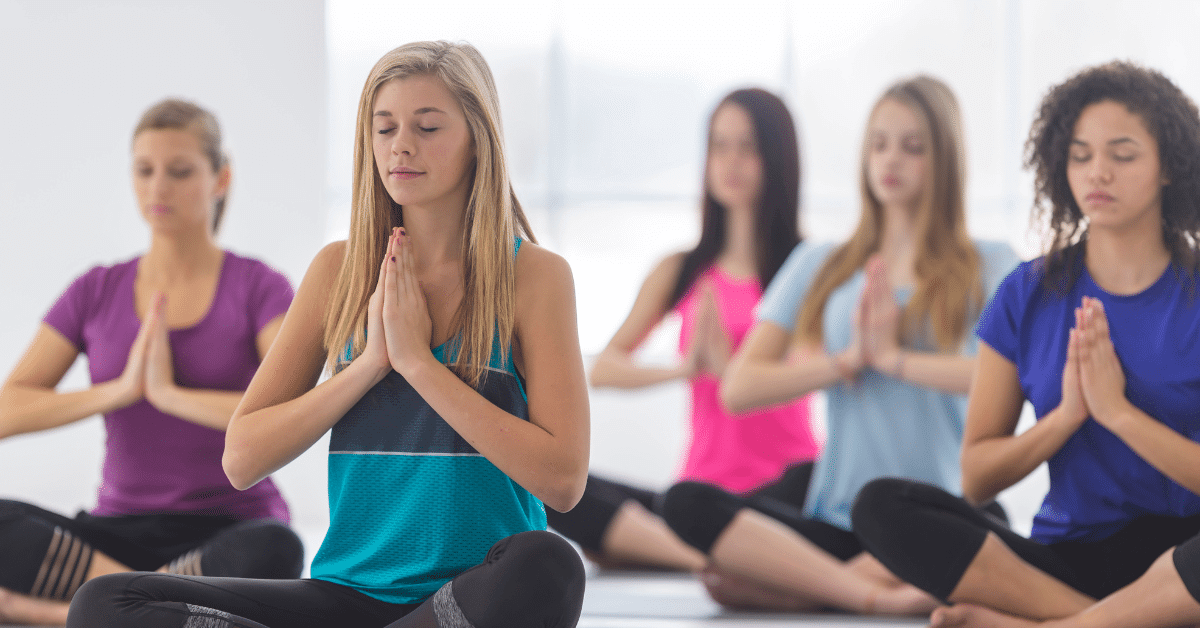We’ve all felt it – that overwhelming pressure, the tightness in our chest, and the constant racing thoughts. Stress is an inevitable part of life, but what if we told you there’s a way to not only manage it but also boost your happiness at the same time?
Enter yoga: an ancient practice with powerful benefits for both mind and body. It’s no secret that countless people around the world have turned to yoga for stress relief 12 amidst their hectic lives. And guess what? We’re about to let you in on their secret.
By incorporating yoga into our daily routine, we can effectively combat stress while simultaneously inviting joy and freedom into our lives. The physical postures combined with mindful breathing techniques work wonders for releasing tension from our bodies and calming our minds.
So why not join us in exploring how this transformative practice can lead to greater happiness? Discover the science behind yoga’s stress-relieving effects and learn three effective poses to help you find serenity through this powerful tool.
Understanding Stress and Its Impact on Your Wellbeing
It’s vital to grasp the effects of stress on our overall wellness, as it plays a significant role in our daily lives. Stress is often considered as an unwelcome visitor that hinders our ability to enjoy life fully and be truly happy.
As we search for ways to cope with stress and reduce its impact, yoga emerges as a powerful tool that not only fosters relaxation but also helps us regain control over our thoughts and emotions. Yoga allows us to connect with ourselves deeply, enabling us to recognize the sources of our anxiety while empowering us with techniques to manage them effectively.
By practicing yoga regularly, we can free ourselves from the shackles of tension and unease, finding solace in the present moment. The combination of stretching exercises, controlled breathing techniques, and mindful meditation inherent in yoga practice promotes both physical and mental relaxation – putting us on the path toward happiness.
As we incorporate yoga into our routine for stress relief and management, it’s essential always to remember that consistency is key. The more frequently we engage in this practice, the better equipped we are at handling life’s challenges without succumbing to overwhelming pressure or distress.
The Science Behind Yoga and Stress Relief
Ever wondered how those deep stretches and mindful breathing can truly be the key to a happier, stress-free life? Well, there’s actual science behind yoga for stress relief and its ability to boost happiness.
When practicing yoga, we focus on our breathing and engage in poses that require us to maintain balance, which helps us stay present in the moment. This act of mindfulness has been shown to reduce cortisol levels in our bodies – the hormone responsible for stress – and increase serotonin production – a neurotransmitter that contributes to feelings of happiness.
The benefits of practicing yoga go beyond just improving flexibility and strength; it also positively impacts our mental well-being. As we hold each pose, we’re encouraged to focus on our breathing, which has a calming effect on our nervous system.
When we’re stressed out, our minds are often cluttered with worries about the past or anxieties about the future. Yoga provides an opportunity for calming and clearing the mind by concentrating solely on breathwork and physical movement.
By training ourselves to remain centered even during challenging poses or moments of discomfort, we develop resilience that serves us well when dealing with everyday stressors.
So next time you roll out your yoga mat or step into your favorite studio class, remember that you’re not only working towards greater flexibility but also investing in your mental health by reducing stress levels.
The more consistently you practice this ancient discipline with intentionality and mindfulness at its core, the better equipped you’ll be at navigating life’s inevitable challenges with grace and ease.
In turn, as you cultivate inner peace through regular practice, don’t be surprised if you notice an undeniable boost in overall happiness too!
3 Effective Yoga Poses to Alleviate Stress
Ready to dive into some transformative stretches and breathe your worries away? Let’s explore a few effective poses that’ll help you unwind and stay centered in the midst of life’s chaos. Incorporating yoga poses for stress relief into your daily routine can work wonders in helping you cope with the demands of modern living.
These relaxing yoga positions have been carefully selected to target areas where tension builds up, allowing us to relieve stress by releasing physical tightness and emotional blockages. One great pose to start with is Child’s Pose (Balasana), which helps reduce stress by encouraging deep breathing and gently stretching the back muscles.
To practice this pose, kneel on your mat with your toes touching and knees wide apart, then sit back onto your heels. Fold forward, extending your arms out in front of you or alongside your body, and let your forehead rest on the mat or on a cushion for added support.
Another powerful stress-relieving practice is Legs-Up-The-Wall Pose (Viparita Karani). This gentle inversion allows gravity to help relax the legs while promoting circulation throughout the entire body. Simply lie down near a wall, scoot your hips as close to it as possible, and extend both legs upward against it while keeping them straight.

A final suggestion for combating tension is Seated Forward Bend (Paschimottanasana) – an excellent stretch that encourages introspection while calming the mind. From a seated position with legs extended straight out in front of you, inhale deeply as you reach towards your toes or place your hands on your shins if reaching all the way is uncomfortable.
With each exhale, gently fold deeper into the pose without straining or compromising form – feel free to use a strap around your feet for assistance if needed! By engaging in these simple yet powerful poses regularly, we can create an oasis of calm amidst our busy lives where tranquility flourishes – one breath at a time!
Incorporating Yoga into Your Daily Routine for Stress Management
Incorporating these practices into your daily routine can significantly enhance your ability to manage life’s pressures and maintain a sense of inner peace. A consistent yoga practice offers stress relief by promoting physical, mental, and emotional well-being.
By setting aside time each day for stress-relieving poses and mindfulness exercises, you’ll be investing in yourself and creating a more balanced life. To seamlessly integrate yoga into your daily routine, consider starting small – even just 10 minutes per day can make a difference in stress management.
You could begin with some gentle stretches or breathing exercises upon waking up in the morning or during a break at work. As you become more comfortable with this new habit, gradually increase the duration and intensity of your practice to suit your needs and preferences.
Remember that consistency is key when it comes to reaping the full benefits of yoga for stress relief. Make it a priority to set aside time each day for your practice, even if it means adjusting other aspects of your schedule.
Over time, you’ll likely find that incorporating yoga into your daily routine not only makes you feel better equipped to handle stressful situations but also brings greater happiness and freedom into all areas of life.
Conclusion
We’ve seen how yoga can be a powerful tool for stress relief and happiness. Imagine being like Sarah, who started practicing yoga daily and noticed her anxiety levels decrease significantly over time.
Let’s make a conscious effort to incorporate yoga into our routines for better mental health. As we experience reduced stress levels, we’ll also be able to lead happier lives.
So, let’s unroll those mats and start this transformative journey!
Frequently Asked Questions
Which Yoga is Best for Reducing Stress?
There are many types of yoga that can help with stress reduction, each offering unique benefits. Hatha Yoga, a slower-paced practice with a focus on breathing and holding poses, is often recommended for beginners and those seeking stress relief. Restorative Yoga uses props to support the body in positions of comfort and ease to facilitate relaxation and health. Meanwhile, Yin Yoga is a slow-paced style where poses are held for longer periods, often beneficial in promoting calmness and flexibility. However, the best yoga for stress reduction varies from person to person and depends on individual preferences and needs.
How Does Yoga Help with Stress Relief?
Yoga can be an effective tool for managing stress because it incorporates several relaxation techniques, such as deep breathing, meditation, and movement. As a mind-body practice, yoga encourages mindfulness, or being present in the moment, which can reduce anxiety and promote calmness. Physically, the various poses in yoga can help reduce muscle tension and promote physical strength and flexibility. Yoga also encourages slower, deeper breathing which helps activate the body’s relaxation response, counteracting the effects of stress.
Is Yoga Good for Stress and Anxiety?
Yes, yoga is an excellent practice for managing stress and anxiety. The combination of physical postures, breathing exercises, and meditation or relaxation in yoga has been shown to improve mental well-being. Regular yoga practice creates mental clarity and calmness, relieves chronic stress patterns, relaxes the mind, and sharpens concentration. It also helps to increase body awareness, which can help a person detect and address areas of stress and anxiety in their body.
What is the Role of Breathing in Yoga for Stress Relief?
Breathing plays a crucial role in yoga for stress relief. Pranayama, or yogic breathing, is a practice in itself, focusing on controlling the breath to manipulate the body’s energy flow. Deep, controlled breathing helps to calm the nervous system, reducing feelings of anxiety and stress. It also helps to focus the mind, distracting it from stressful thoughts. In yoga, breath control is used in conjunction with physical poses to deepen the effects of the postures and further promote relaxation and stress relief.
How does the mind-body connection in yoga contribute to mental well-being?
The mind-body connection in yoga contributes to mental well-being through a combination of physical poses, controlled breathing, and meditation or relaxation. This combination helps reduce stress, lower blood pressure, and decrease heart rate, which all promote mental well-being. Yoga can also enhance mood, improve concentration, and reduce symptoms of anxiety and depression. It promotes self-awareness and mindfulness, leading to a more balanced emotional state. The physical aspect of yoga also releases endorphins, which are natural mood lifters.




